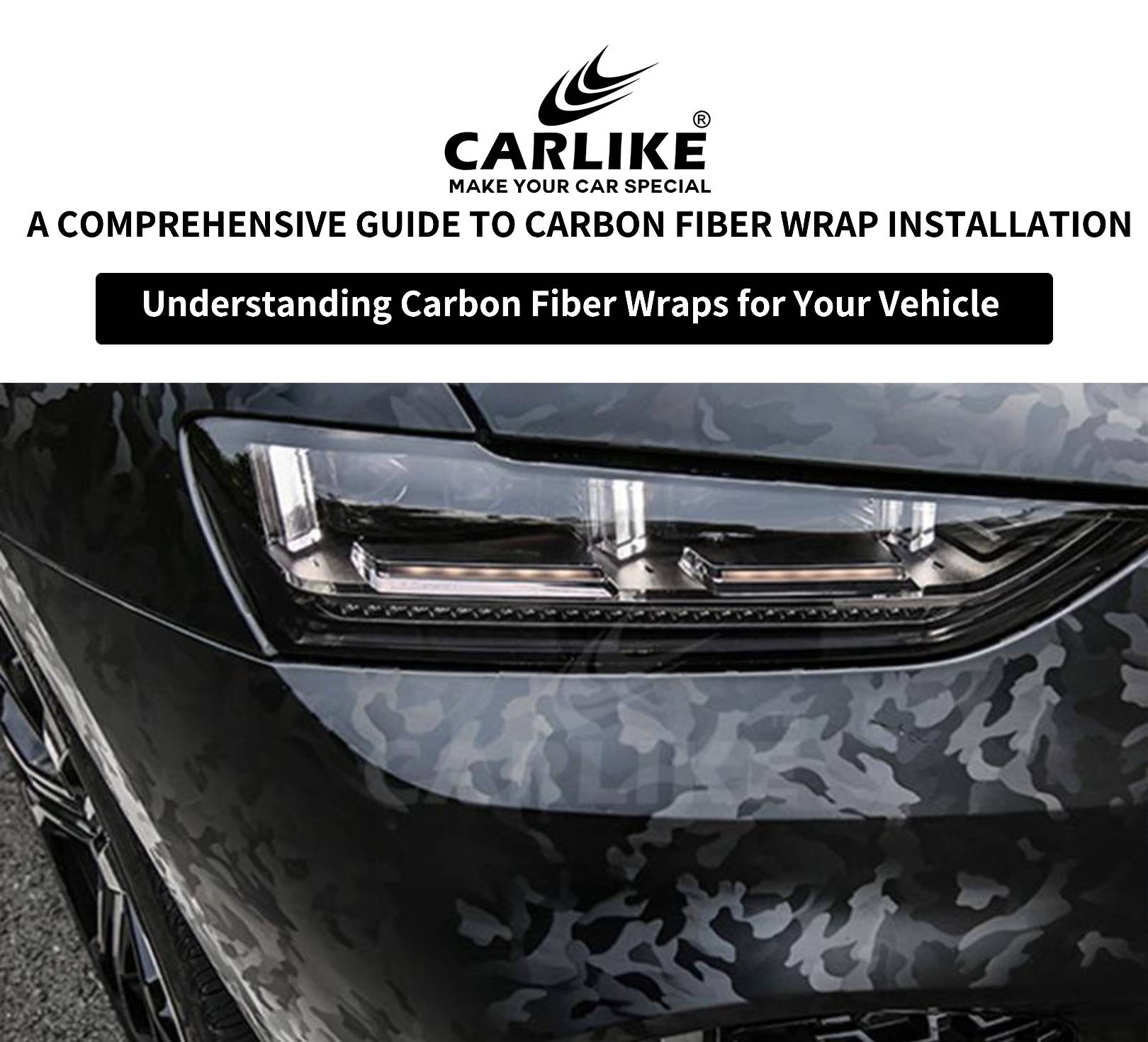Product Warranty
PRODUCT WARRANTY
CARLIKE ® warranty policy:
| Item | Quality warranty |
|
CARLIKE 3000P Series PET Liner |
2 Years |
|
CARLIKE 3000 Series Paper Liner |
2 Years |
|
CARLIKE 5000 Series TPU Transparent, TPU Colored |
5 Years |
Introduction
What is Vinyl Wrapping?
Vinyl wrapping is a process where a thin, adhesive-backed vinyl film is applied to the surface of a vehicle. This film can be used to change the color or finish of the car, add designs, or protect the original paintwork. Vinyl wraps come in a variety of finishes, including matte, gloss, satin, and textured options like carbon fiber or brushed metal.
Benefits of Vinyl Wrapping
Aesthetic Customization : Vinyl wraps allow for endless customization options, enabling car owners to personalize their vehicles with unique colors, patterns, and designs.
Paint Protection : The wrap acts as a protective layer, shielding the original paint from UV rays, minor scratches, and road debris, which helps maintain the car's resale value.
Cost-Effective : Compared to a full paint job, vinyl wrapping is often more affordable and less time-consuming.
Reversibility : Vinyl wraps can be removed without damaging the original paint, allowing car owners to revert to the vehicle's original look or change the design as desired.
Durability : High-quality vinyl wraps can last several years with proper maintenance, offering long-term benefits.
Determining the Amount of Vinyl Needed for Wrapping a Car
When considering a vinyl wrap for your car, one crucial factor is determining the amount of vinyl required for the job. The amount of vinyl needed depends on several factors, including the size and type of the vehicle, the complexity of its contours, and the specific areas being wrapped (e.g., full wrap vs. partial wrap). This topic involves understanding the measurements of your vehicle, accounting for extra material to cover errors and complex areas, and choosing the right type and quality of vinyl to ensure a seamless application.

Factors Affecting Vinyl Wrap Quantity
Factors Affecting Vinyl Quantity
Car Size and Type
Different car sizes and types require varying amounts of vinyl due to their unique dimensions and surface areas. Here’s a general estimate for the amount of vinyl needed for different car types:
- Compact Cars (e.g., Mini Cooper): Typically require about 50-55 feet of vinyl wrap.
- Sedans (e.g., Honda Accord): Usually need around 60-70 feet of vinyl wrap.
- SUVs (e.g., Ford Explorer): Often require 75-85 feet of vinyl wrap.
- Trucks (e.g., Ford F-150): Generally need about 85-100 feet of vinyl wrap.
Car Complexity
The design and contours of a car significantly impact the amount of vinyl required. Cars with more curves, intricate designs, and complex body parts will need more vinyl. Here are some specific considerations:
- Curves and Contours: More curves and contours increase the surface area that needs to be covered, thereby requiring more vinyl.
- Bumpers: These are often more complex and may require additional material to ensure full coverage without wrinkles or bubbles.
- Mirrors and Spoilers: These accessories add to the surface area and complexity of the wrap. They often require extra vinyl to cover adequately.
- Roof and Hood: Large, flat surfaces can use significant amounts of vinyl, especially if they have design features or contours.
Vinyl Width and Length
Standard vinyl roll sizes also play a role in determining how much material is needed. Typically, vinyl wraps come in rolls that are:
- Width: 60 inches (5 feet)
- Length: Rolls can vary but are often sold in lengths of 25, 50, or 75 feet.
When planning for a vinyl wrap, it’s important to consider the following:
- Overlap: To ensure seamless application and prevent peeling, overlapping sections of vinyl is necessary. This requires additional material beyond the exact dimensions of the car.
- Potential Mistakes: Mistakes during application are common, especially for those new to wrapping. It’s advisable to have extra vinyl on hand to account for any errors or reapplications needed.

Calculating Vinyl Wrap Amount
Step-by-Step Guide to Measuring a Car for Vinyl Wrap
1. Gather Your Materials
- Tape measure
- Notepad and pen
- Calculator
- Vinyl wrap roll dimensions (width and length)
2. Measure the Car
-
Measure the Length :
- Measure from the front bumper to the rear bumper along the side of the car.
- Write down the measurement.
-
Measure the Width :
- Measure from the left side of the car to the right side, including the widest points such as mirrors or side mirrors if they extend outward.
- Write down the measurement.
-
Measure the Height :
- Measure from the ground to the highest point of the car, usually the roof.
- Write down the measurement.
3. Calculate the Surface Area
-
Estimate the Surface Area :
- For a rough estimate, use the formula:Surface Area=(Length×Width)+(Length×Height)+(Width×Height) \text{Surface Area} = (\text{Length} \times \text{Width}) + (\text{Length} \times \text{Height}) + (\text{Width} \times \text{Height})Surface Area=(Length×Width)+(Length×Height)+(Width×Height)
- This calculation gives a rough estimate, as the actual surface area is more complex due to curves and contours.
-
Add Extra for Mistakes and Overlaps :
- Add 10-20% to the calculated surface area to account for mistakes, overlaps, and trimming.
- For example, if your calculated surface area is 300 square feet, you should plan for approximately 330-360 square feet.
4. Factor in the Vinyl Roll Dimensions
-
Know the Vinyl Roll Dimensions :
- Most vinyl rolls come in standard widths (e.g., 60 inches) and lengths (e.g., 25 feet).
- Convert these dimensions into square feet.Roll Area=Roll Width (ft)×Roll Length (ft)
- For example, a roll that is 5 feet wide and 25 feet long provides:Roll Area=5 ft×25 ft=125 square feet
-
Calculate How Many Rolls Are Needed :
- Divide the total area needed (including extra) by the roll area to determine how many rolls you need.Number of Rolls=Total Area/NeededRoll Area
- Round up to the nearest whole number since vinyl rolls cannot be purchased in fractions.
5. Example Calculation
-
Assume:
- Length: 15 feet
- Width: 6 feet
- Height: 5 feet
- Calculated Surface Area:(15×6)+(15×5)+(6×5)=90+75+30=195 square feet
- Adding 20% extra:195 square feet×1.20=234 square feet
- Vinyl Roll Dimensions: 5 feet wide and 25 feet long (125 square feet per roll)
- Rolls Needed:234125≈1.87 rolls
- Round up to 2 rolls.






